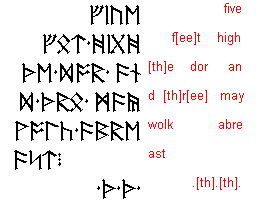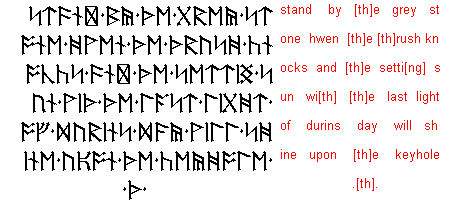
After the Runes came to Britain, many local variations developed. J.R.R.Tolkien used one if these variations in his book "The Hobbit". These Runic inscriptions appear on Thrain's map of Lonely Mountain. Here are the two inscriptions with translation:
Right-side of Map Inscription:

Moon-Letter Inscription:

Why were the Dwarves using Anglo/Saxon Runes for these inscriptions instead of the Angerthas/Cirth Runes (described in "The Lord of the Rings", Appendix E) ?
In order to write "The Hobbit", Tolkien had to developed a culture for the Dwarves. The Dwarves were known for and prized their expertise in mining and their craftsmanship in wood, stone and metal- working. Although they were equally skilled as calligraphers, employing most of the writing systems in Middle-earth, when writing for themselves, they preferred to a Runic style alphabet.
I believe that Tolkien planned for the Dwarves to use a Runic alphabet unique to Middle-earth, but when "The Hobbit" was written (in 1937), he had not yet invented the Elvish Angerthas/Cirth Runic alphabet that the Dwarves would eventually come to use.
In "The Hobbit", the words of the Hobbits, the Elves, the Goblins and the Dwarves are all translated into English. Likewise the Runic inscriptions are written with the more familiar English or Anglo/Saxon Runes rather than the Elvish/Dwarvish Angerthas/Cirth Runes of Middle-earth.
Primary sources:
"The Hobbit" by J. R. R. Tolkien
Houghton-Mifflin
ISBN 0-395-28265-9
"The Return of the King" by J. R. R. Tolkien
Appendix E
Houghton-Mifflin
ISBN 0-395-27221-1
|
Back to Main page. Last updated: November 2, 1999 |
Copyright © 1995-1999 Daniel Steven Smith Frequently Asked Questions |